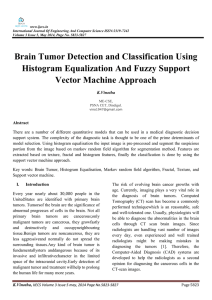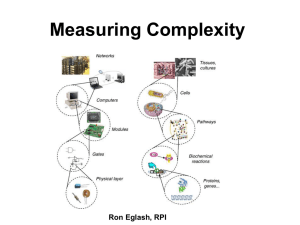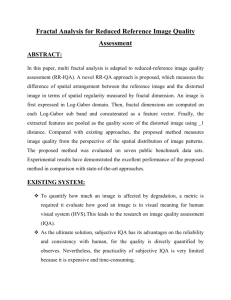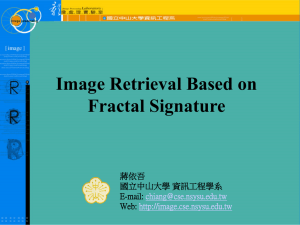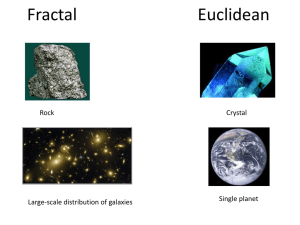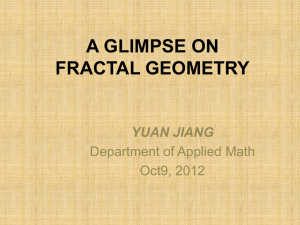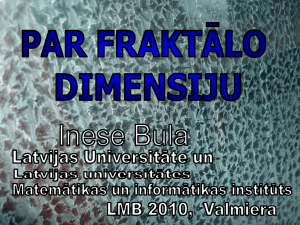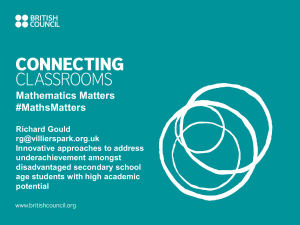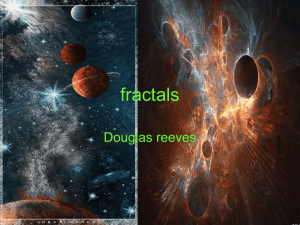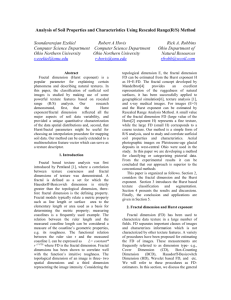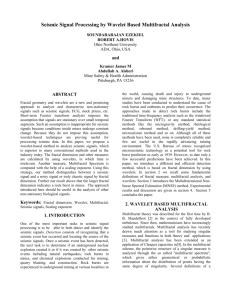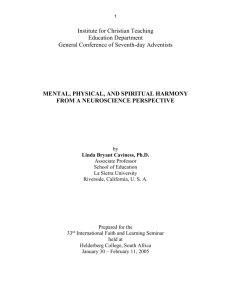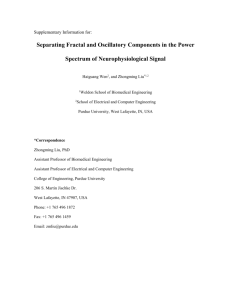Module Specification
advertisement
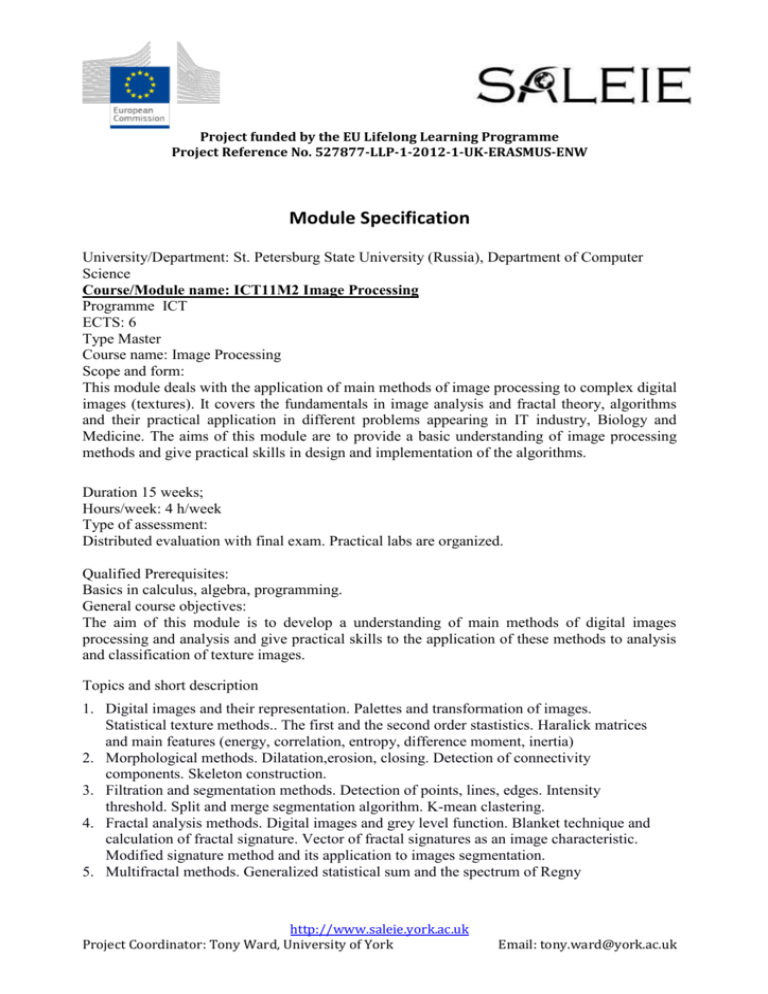
Project funded by the EU Lifelong Learning Programme Project Reference No. 527877-LLP-1-2012-1-UK-ERASMUS-ENW Module Specification University/Department: St. Petersburg State University (Russia), Department of Computer Science Course/Module name: ICT11M2 Image Processing Programme ICT ECTS: 6 Type Master Course name: Image Processing Scope and form: This module deals with the application of main methods of image processing to complex digital images (textures). It covers the fundamentals in image analysis and fractal theory, algorithms and their practical application in different problems appearing in IT industry, Biology and Medicine. The aims of this module are to provide a basic understanding of image processing methods and give practical skills in design and implementation of the algorithms. Duration 15 weeks; Hours/week: 4 h/week Type of assessment: Distributed evaluation with final exam. Practical labs are organized. Qualified Prerequisites: Basics in calculus, algebra, programming. General course objectives: The aim of this module is to develop a understanding of main methods of digital images processing and analysis and give practical skills to the application of these methods to analysis and classification of texture images. Topics and short description 1. Digital images and their representation. Palettes and transformation of images. Statistical texture methods.. The first and the second order stastistics. Haralick matrices and main features (energy, correlation, entropy, difference moment, inertia) 2. Morphological methods. Dilatation,erosion, closing. Detection of connectivity components. Skeleton construction. 3. Filtration and segmentation methods. Detection of points, lines, edges. Intensity threshold. Split and merge segmentation algorithm. K-mean clastering. 4. Fractal analysis methods. Digital images and grey level function. Blanket technique and calculation of fractal signature. Vector of fractal signatures as an image characteristic. Modified signature method and its application to images segmentation. 5. Multifractal methods. Generalized statistical sum and the spectrum of Regny http://www.saleie.york.ac.uk Project Coordinator: Tony Ward, University of York Email: tony.ward@york.ac.uk Project funded by the EU Lifelong Learning Programme Project Reference No. 527877-LLP-1-2012-1-UK-ERASMUS-ENW dimensions. Multifractal spectrum and methods of calculations. Density function and level sets. Calculation of multifractal spectrum based on generalized statistical sum. Image segmentation based on density function calculation. Learning outcomes Knowledge The fundamentals of digital images representation and transformation The fundamentals of morphological methods, filtration and segmentation The fundamentals of fractal dimensions and fractal analysis methods Skills Able to comprehend main color palettes and transformation from one to another. Able to implement algorithms for main methods of filtration and segmentation To design and implement fractal analysis algorithms to classify images with complex structures Competences Able to select the most appropriate image representation Able to comprehend the applicability of morphological methods and filtration to different sorts of images Students have to be able to select, design and implement the appropriate method of analysis Course recommended literature (in accordance with topics) Topic 1 1. R. Haralick, K. Shanmugam, I. Dinstein. Textural Features for Image Classification. IEEE Transactions on Systems, Man and Cybernetics, No. 6, pp. 610-621, (1973). 2. R. Haralick. Statistical and Structural Approaches to Texture. Proceedings of the IEEE, Vol. 67, No. 5, pp. 786-804, (1979). 3. M. Tuceryan, A. Jain. Texture analysis. The Handbook of Pattern Recognition and Computer Vision, 2nd Ed., by C. Chen, L. Pau, P. Wang (eds.), World Scientific Publishing Co., pp. 207-248, (1998). Topics 2, 3 1. R. Gonzales, R.Woods. Digital image processing. Prentice Hall, 2008. 2. N. Pal, S. Pal. A Review on Image Segmentation Techniques. Pattern Recognition,Vol. 26, No. 9, pp. 1277-1294, (1993). 3. B. M. Faruquzzaman, N. R. Paiker, J. Arafat, Z. Karim, M. Ali Ameer ,"Object segmentation based on split and merge algorithm," TENCON 2008, IEEE Region 10 Conference, pp. 1- 4, (2008). Topics 4,5 http://www.saleie.york.ac.uk Project Coordinator: Tony Ward, University of York Email: tony.ward@york.ac.uk Project funded by the EU Lifelong Learning Programme Project Reference No. 527877-LLP-1-2012-1-UK-ERASMUS-ENW 1. B. Mandelbrot. The fractal geometry of nature. Henry Holt and Company, 1983 2. M. Schroeder. Fractals, chaos, power laws. New York, 1991. 3. Falconer K. J. Fractal Geometry. Mathematical Foundations and Applications. — John Wiley & Sons, 1990. 4. Peleg Shmuel, Naor Joseph, Hartley Ralph, Avnir David. Multiple Resolution Texture Analysis and Classification. IEEE Transactions on pattern analysis and machine intelligence, vol. PAMI-6, NO. 4, July 1984 5. Xu Y., Ji H., Fermüller C. Viewpoint Invariant Texture Description Using Fractal Analysis. — International Journal of Computer Vision, no. 83, 2009, pp. 85–100. 6. N. Ampilova, I. Soloviev, Y. Shupletsov. On Application of Fractal Analysis Methods to Biomedical Preparation Images. e-journal “Differential equations and control processes”, www.math.spbu.ru/diffjournal, no.2, 2013, p.51-61. Special Considerations: Generically none for this module but should be commented on by the institution delivering the module. http://www.saleie.york.ac.uk Project Coordinator: Tony Ward, University of York Email: tony.ward@york.ac.uk
